The Ashoka Samrat.
Ashoka
The Great History Of The Indian King Ashoka.
|
| Ashoka | |
|---|---|
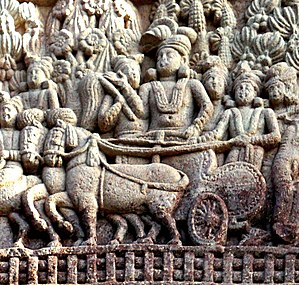 | |
| 3rd Mauryan emperor | |
| Reign | c. 268 – c. 232 BCE |
| Coronation | 268 BCE |
| Predecessor | Bindusara |
| Successor | Dasharatha |
| Regent | Radhagupta |
| Born | Pataliputra, modern-day Patna, Bihar, India |
| Died | 232 BCE Pataliputra, modern-day Patna, Bihar, India |
| Spouse | |
| Issue | |
| Dynasty | Maurya |
| Father | Bindusara |
| Mother | Subhadrangi (also called Dharma) |
| Maurya Empire (322–180 BCE) | ||||||||||||||||||||
|---|---|---|---|---|---|---|---|---|---|---|---|---|---|---|---|---|---|---|---|---|
| ||||||||||||||||||||
 𑀓), sometimes Ashoka the Great, was an Indian emperor of the Maurya Dynasty, who ruled almost all of the Indian subcontinent from c. 268 to 232 BCE. The grandson of the founder of the Maurya Dynasty, Chandragupta Maurya, Ashoka promoted the spread of Buddhism. Considered by many to be one of India's greatest emperors, Ashoka expanded Chandragupta's empire to reign over a realm stretching from present-day Afghanistan in the west to Bangladesh in the east. It covered the entire Indian subcontinent except for parts of present-day Tamil Nadu, Karnataka and Kerala. The empire's capital was Pataliputra (in Magadha, present-day Patna), with provincial capitals at Taxila and Ujjain.
𑀓), sometimes Ashoka the Great, was an Indian emperor of the Maurya Dynasty, who ruled almost all of the Indian subcontinent from c. 268 to 232 BCE. The grandson of the founder of the Maurya Dynasty, Chandragupta Maurya, Ashoka promoted the spread of Buddhism. Considered by many to be one of India's greatest emperors, Ashoka expanded Chandragupta's empire to reign over a realm stretching from present-day Afghanistan in the west to Bangladesh in the east. It covered the entire Indian subcontinent except for parts of present-day Tamil Nadu, Karnataka and Kerala. The empire's capital was Pataliputra (in Magadha, present-day Patna), with provincial capitals at Taxila and Ujjain.
Ashoka waged a destructive war against the state of Kalinga (modern Odisha), which he conquered in about 260 BCE. In about 263 BCE, he converted to Buddhism after witnessing the mass deaths of the Kalinga War, which he had waged out of a desire for conquest and which reportedly directly resulted in more than 100,000 deaths and 150,000 deportations. He is remembered for the Ashoka pillars and edicts, for sending Buddhist monks to Sri Lanka and Central Asia, and for establishing monuments marking several significant sites in the life of Gautama Buddha.
➣Biography
➩Ashoka's early life
Ashoka was born to the Mauryan emperor, Bindusara and Subhadrangī (or Dharmā). He was the grandson of Chandragupta Maurya, founder of the Maurya dynasty, who was born in a humble family, and with the counsel of Chanakya ultimately built one of the largest empires in ancient India. According to Roman historian Appian, Chandragupta had made a "marital alliance" with Seleucus; there is thus a possibility that Ashoka had a Seleucid Greek grandmother. An Indian Puranic source, the Pratisarga Parva of the Bhavishya Purana, also described the marriage of Chandragupta with a Greek ("Yavana") princess, daughter of Seleucus.
The ancient Buddhist, Hindu, and Jain texts provide varying biographical accounts. The Avadana texts mention that his mother was queen Subhadrangī. According to the Ashokavadana, she was the daughter of a Brahmin from the city of Champa. She gave him the name Ashoka, meaning "one without sorrow". The Divyāvadāna tells a similar story, but gives the name of the queen as Janapadakalyānī. Ashoka had several elder siblings, all of whom were his half-brothers from the other wives of his father Bindusara. Ashoka was given royal military training.
➣Marriage
From the various sources that speak of his life, Ashoka is believed to have had five wives. They were named Devi (or Vedisa-Mahadevi-Shakyakumari), the second queen, Karuvaki, Asandhimitra(designated agramahisī or "chief queen"), Padmavati, and Tishyarakshita. He is similarly believed to have had four sons and two daughters: a son by Devi named Mahendra (Pali: Mahinda), Tivara (son of Karuvaki), Kunala (son of Padmavati, and Jalauka (mentioned in the Kashmir Chronicle), a daughter of Devi named Sanghamitra (Pali: Sanghamitta), and another daughter named Charumati.
According to one version of the Mahavamsa, the Buddhist chronicle of Sri Lanka, Ashoka, when he was heir-apparent and was journeying as Viceroy to Ujjain, is said to have halted at Vidisha (10 kilometers from Sanchi), and there married the daughter of a local banker. She was called Devi and later gave Ashoka two sons, Ujjeniya and Mahendra, and a daughter Sanghamitta. After Ashoka's accession, Mahendra headed a Buddhist mission, sent probably under the auspices of the Emperor, to Sri Lanka.
Sangha"), who established Buddhism in Ceylon (now Sri Lanka).
➣Death and legacy
Ashoka ruled for an estimated 36 years and died in 232 BCE. Legend states that during his cremation, his body burned for seven days and nights. After his death, the Mauryan dynasty lasted just fifty more years until his empire stretched over almost all of the Indian subcontinent. Ashoka had many wives and children, but many of their names are lost to time. His chief consort (agramahisi) for the majority of his reign was his wife, Asandhimitra, who apparently bore him no children.
In his old age, he seems to have come under the spell of his youngest wife Tishyaraksha. It is said that she had got Ashoka's son Kunala, the regent in Takshashila and the heir presumptive to the throne, blinded by a wily stratagem. The official executioners spared Kunala and he became a wandering singer accompanied by his favourite wife Kanchanmala. In Pataliputra, Ashoka heard Kunala's song, and realised that Kunala's misfortune may have been a punishment for some past sin of the emperor himself. He condemned Tishyaraksha to death, restoring Kunala to the court. In the Ashokavadana, Kunala is portrayed as forgiving Tishyaraksha, having obtained enlightenment through Buddhist practice. While he urges Ashoka to forgive her as well, Ashoka does not respond with the same forgiveness. Kunala was succeeded by his son, Samprati, who ruled for 50 years until his death.
In the year 185 BCE, about fifty years after Ashoka's death, the last Maurya ruler, Brihadratha, was assassinated by the commander-in-chief of the Mauryan armed forces, Pushyamitra Shunga, while he was taking the Guard of Honor of his forces. Pushyamitra Shunga founded the Shunga dynasty (185-75 BCE) and ruled just a fragmented part of the Mauryan Empire. Many of the northwestern territories of the Mauryan Empire (modern-day Afghanistan and Northern Pakistan) became the Indo-Greek Kingdom.
King Ashoka, the third monarch of the Indian Mauryan dynasty, is also considered as one of the most exemplary rulers who ever lived.
➣Symbolism
The caduceus appears as a symbol of the punch-marked coins of the Maurya Empire in India, in the 3rd-2nd century BCE. Numismatic research suggests that this symbol was the symbol of king Ashoka, his personal "Mudra". This symbol was not used on the pre-Mauryan punch-marked coins, but only on coins of the Maurya period, together with the three arched-hill symbol, the "peacock on the hill", the triskelis and the Taxila mark.
➣Legends of Ashoka
Until the Ashokan inscriptions were discovered and deciphered, stories about Ashoka were based on the legendary accounts of his life and not strictly on historical facts. These legends were found in Buddhist textual sources such as the text of Ashokavadana. The Ashokavadana is a subset of a larger set of legends in the Divyavadana, though it could have existed independently as well. Following are some of the legends narrated in the Ashokavadana about Ashoka:
1) One of the stories talks about an event that occurred in a past life of Ashoka, when he was a small child named Jaya. Once when Jaya was playing on the roadside, the Buddha came by. The young child put a handful of earth in the Buddha's begging bowl as his gift to the saint and declared his wish to one day become a great emperor and follower of the Buddha. The Buddha is said to have smiled a smile that “illuminated the universe with its rays of light”.
2) Another story aims to portray Ashoka as an evil person in order to convey the importance of his transformation into a good person upon adopting Buddhism. It begins by stating that due to Ashoka's physical ugliness he was disliked by his father Bindusara. Ashoka wanted to become king and so he got rid of the heir by tricking him into entering a pit filled with live coals. He became famous as “Ashoka the Fierce” because of his wicked nature and bad temper. He is said to have subjected his ministers to a test of loyalty and then have 500 of them killed for failing it.
➣Ashoka and the relics of the Buddha
According to Buddhist legend, particularly the Mahaparinirvana, the relics of the Buddha had been shared among eight countries following his death. Ashoka endeavoured to take back the relics and share them among 84,000 stupas. This story is amply depicted in the reliefs of Sanchi and Bharhut. According to the legend, Ashoka obtained the ashes from seven of the countries, but failed to take the ashes from the Nagas at Ramagrama. This scene is depicted on the tranversal portion of the southern gateway at Sanchi.

➣Ashoka Chakra
 The Ashoka Chakra (the wheel of Ashoka) is a depiction of the Dharmachakra (the Wheel of Dharma). The wheel has 24 spokes which represent the 12 Laws of Dependent Origination and the 12 Laws of Dependent Termination. The Ashoka Chakra has been widely inscribed on many relics of the Mauryan Emperor, most prominent among which is the Lion Capital of Sarnath and The Ashoka Pillar. The most visible use of the Ashoka Chakra today is at the centre of the National flag of the Republic of India (adopted on 22 July 1947), where it is rendered in a Navy-blue color on a White background, by replacing the symbol of Charkha (Spinning wheel) of the pre-independence versions of the flag. The Ashoka Chakra can also been seen on the base of the Lion Capital of Ashoka which has been adopted as the National Emblem of India.
The Ashoka Chakra (the wheel of Ashoka) is a depiction of the Dharmachakra (the Wheel of Dharma). The wheel has 24 spokes which represent the 12 Laws of Dependent Origination and the 12 Laws of Dependent Termination. The Ashoka Chakra has been widely inscribed on many relics of the Mauryan Emperor, most prominent among which is the Lion Capital of Sarnath and The Ashoka Pillar. The most visible use of the Ashoka Chakra today is at the centre of the National flag of the Republic of India (adopted on 22 July 1947), where it is rendered in a Navy-blue color on a White background, by replacing the symbol of Charkha (Spinning wheel) of the pre-independence versions of the flag. The Ashoka Chakra can also been seen on the base of the Lion Capital of Ashoka which has been adopted as the National Emblem of India.
The Ashoka Chakra was created by Ashoka during his reign. Chakra is a Sanskrit word which also means "cycle" or "self-repeating process". The process it signifies is the cycle of time—as in how the world changes with time.
A few days before India became independent in August 1947, the specially-formed Constituent Assembly decided that the flag of India must be acceptable to all parties and communities. A flag with three colours, Saffron, White and Green with the Ashoka Chakra was selected.
➣Lion Capital of Ashoka (Ashokmudra)
The Lion capital of Ashoka is a sculpture of four lions standing back to back. It was originally placed atop the Ashoka pillar at Sarnath, now in the state of Uttar Pradesh, India. The pillar, sometimes called the Ashoka Column, is still in its original location, but the Lion Capital is now in the Sarnath Museum. This Lion Capital of Ashoka from Sarnath has been adopted as the National Emblem of India and the wheel ("Ashoka Chakra") from its base was placed onto the center of the National Flag of India.
The four animals in the Sarnath capital are believed to symbolise different steps of Lord Buddha's life.
- The Elephant represents the Buddha's idea in reference to the dream of Queen Maya of a white elephant entering her womb.
- The Bull represents desire during the life of the Buddha as a prince.
- The Horse represents Buddha's departure from palatial life.
- The Lion represents the accomplishment of Buddha.





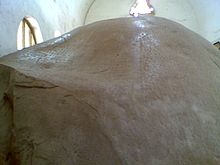


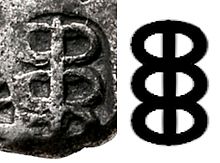

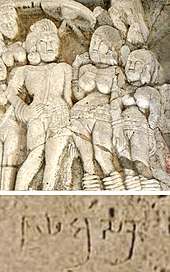
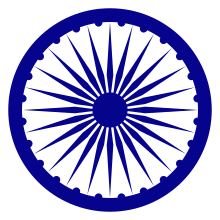
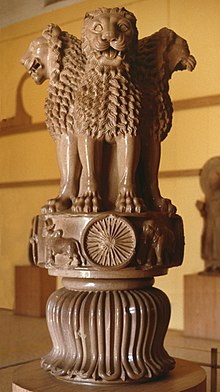
Comments
Post a Comment